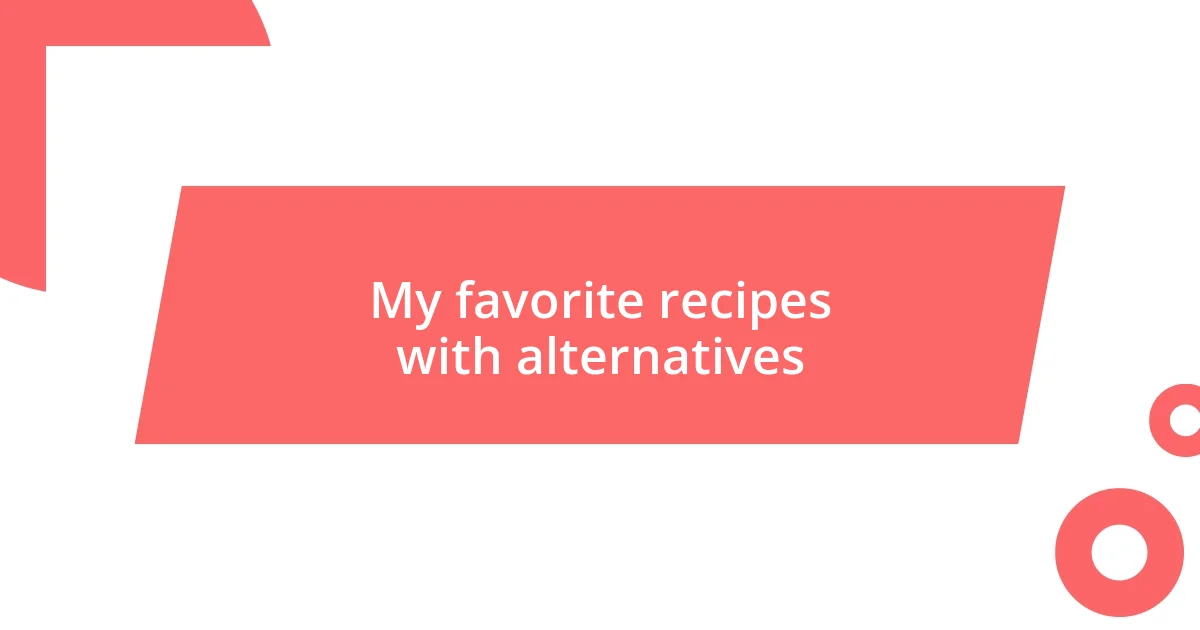Key takeaways:
- Experimenting with various flour alternatives like almond, coconut, and chickpea flours enhances flavor, texture, and creativity in baking and cooking.
- Understanding the specific properties of each flour, such as absorbency and required ingredient adjustments, is crucial for successful outcomes.
- Baking with alternatives not only accommodates dietary restrictions but also fosters inclusive experiences and culinary adventures.

My journey with flour alternatives
I remember the first time I attempted to bake with almond flour. I was excited yet nervous, as I had seen countless recipes that claimed it could be a game-changer. The texture of my cookies came out wonderfully soft, but they crumbled easily. Have you ever experienced that sheer joy of a new ingredient combined with the impending dread of something going wrong?
As I experimented further, I discovered coconut flour, which was a whole different ball game. Have you ever tried it? The absorbency of coconut flour amazed me, but I quickly learned the hard way that I needed to adjust my liquid ratios. The first batch of pancakes I made was a thick, gluey mess that, if I’m honest, tasted a bit like cardboard! There was a moment when I felt defeated, yet I realized that each mishap brought me closer to mastering these alternatives.
Then came the day I mixed chickpea flour into my savory recipes. I was skeptical at first; it seemed so foreign. But the nutty flavor paired perfectly with my favorite spices, turning simple dishes into something truly special. It made me wonder, why hadn’t I tried this sooner? Each journey with these alternatives wasn’t merely about cooking; it unveiled a new path to explore flavors and textures that nourished my creativity in the kitchen.

Understanding the need for alternatives
Understanding the need for alternatives in baking became clear as I explored dietary restrictions and health trends. Many people are moving towards gluten-free diets or seeking to reduce carbohydrates for health reasons. It’s fascinating how necessity often drives innovation in our kitchens, pushing us to find satisfying substitutes. I’ve had friends who couldn’t enjoy traditional baked goods, and through my experiments, I realized that providing options meant creating inclusive experiences for everyone.
- Alternatives cater to various dietary needs, such as gluten intolerance or nut allergies.
- They can provide a healthier option, often with higher nutritional values.
- Experimenting with these substitutes can unlock new flavors and textures in your cooking.
- Many alternatives are less processed, which aligns with a clean eating lifestyle.
- They encourage creativity in the kitchen, giving cooks a chance to innovate.
Reflecting on my own journey, I recall feeling slightly overwhelmed by the choices available, but it was that very exploration that ignited my passion for baking. Each flour alternative serves as a reminder that our culinary creativity knows no bounds, often leading us to unexpected delights.

Exploring popular flour substitutes
Exploring flour substitutes has been an enlightening experience for me. For instance, I dabbled with oat flour when I wanted to create a lighter pancake. The result was delightfully fluffy, with a hint of nuttiness. However, I learned that it can absorb more liquid than regular flour, so I had to experiment with the proportions until I found the perfect balance. Have you ever found yourself tweaking a recipe until it was just right?
Another flour alternative worth mentioning is rice flour. I was taken aback when I tried using it in my savory dishes. It added a crispiness that I hadn’t expected, especially when making tempura! But, I found that it can sometimes lack the structure needed for baked goods, which means it’s best paired with other flours. It’s thrilling how each alternative not only changes the texture of the food but also expands the flavor profile.
Then there’s the wonder of buckwheat flour, which I initially overlooked. The earthy flavor it brings is phenomenal, especially in pancakes or quick breads. I remember the first time I incorporated it into my baking – it was like uncovering a hidden gem in my pantry. Just like the previous substitutes, I had to keep in mind that buckwheat can be more absorbent, so adjusting liquid amounts was key. Every time I try a new flour, I feel like I’m on a delicious adventure!
| Flour Type | Features |
|---|---|
| Almond Flour | Great for moist baked goods; requires adjustments for texture. |
| Coconut Flour | Highly absorbent; increases liquid need significantly. |
| Chickpea Flour | Nutty flavor; excellent for savory dishes. |
| Oat Flour | Fluffy texture; can absorb more liquid than wheat flour. |
| Rice Flour | Crispiness; may lack structure for certain baked goods. |
| Buckwheat Flour | Earthy taste; requires liquid adjustments. |

Baking with almond flour
Baking with almond flour has been nothing short of a revelation for me. The first time I replaced regular flour with it in my chocolate chip cookies, I was pleasantly surprised. The cookies turned out so moist and tender, unlike anything I had ever made before. Have you ever discovered an ingredient that completely transforms your favorite recipe? With almond flour, I found that I had to play around with the proportions a bit, but the flavor was nutty and rich, making the effort worth every bite.
As I continued my journey, I realized that almond flour works beautifully in cakes, particularly in recipes that call for a denser texture. I vividly remember baking an almond flour lemon cake for a friend’s birthday. The zesty flavor paired with the flour resulted in a delightful treat that everyone raved about. What amazed me the most was the way it paired with other ingredients, enhancing the overall experience. If you’ve never tried almond flour, trust me—it adds a lovely, unique dimension that you won’t soon forget.
One of the most important lessons I learned was about adjusting the other ingredients. Almond flour lacks gluten, which means it behaves differently in baked goods. The first time I made pancakes with it, they were a little too crumbly. It was a bit disheartening at first, but after a few tweaks with the liquid and egg content, I was able to create a fluffy breakfast that made my family smile. Isn’t it fascinating how a little experimentation can lead to such delicious outcomes? In my experience, almond flour invites not just creativity but a sense of adventure in baking.

Cooking with coconut flour
When I first ventured into cooking with coconut flour, I was taken aback by its absorbency. I recall making a simple pancake recipe, and to my surprise, I ended up needing to double the liquid to achieve a decent batter consistency. Have you ever found yourself scrambling to adjust a recipe on the fly? It was a bit of a scramble, but that experimentation led to some wonderfully fluffy pancakes that loved a drizzle of maple syrup.
I’ve also had great success incorporating coconut flour into my baking for treats like muffins. The subtle coconut flavor adds an inviting twist, especially when paired with chocolate chips or berries. I remember biting into a coconut flour blueberry muffin and feeling a sense of delight wash over me; it was sweet, moist, and had a lovely crumb. However, the consistency can be quite different compared to conventional flours, which means you might need to play around with the ratios to find what works best for your taste and texture preferences.
One thing that truly struck me is the need for additional eggs when using coconut flour. I completely learned this the hard way during my first attempt at brownies. The result? A dense, almost gooey mixture that was far from my envisioned fudgy delight. After adjusting the recipe to include an extra egg, everything came together beautifully. It’s remarkable how one small tweak can elevate a dish from a potential flop to a fantastic treat, right? Cooking with coconut flour has been a journey full of surprises, and I’ve enjoyed every minute of it.

Tips for using chickpea flour
When I started experimenting with chickpea flour, I quickly learned that its unique properties require a bit of finesse. The first time I used it to make falafel, I remember feeling like a kid in a candy store. The flour’s earthy flavor provided an incredible depth, but I quickly realized that soaking the flour in water for a bit helped the texture immensely. Have you ever experienced the magic of an ingredient transforming a classic dish? For me, that was a game changer.
Another tip that really made a difference was adjusting the baking time. Chickpea flour tends to brown faster than regular flour, and I recall nearly burning a batch of pancakes because I was caught up in the moment. It was a crucial reminder: keep a close eye on your cooking! Just a couple of minutes can turn an ideal golden brown into something a tad too crispy. Learning to trust my instincts in the kitchen was a beautiful lesson that I carry into every dish I create.
Finally, I discovered that chickpea flour pairs wonderfully with spices. When I made a savory chickpea flour pancake, adding cumin and coriander transformed the flavor profile entirely. I had never felt so adventurous in my culinary journey. Anyone else out there an experimental cook? The dish turned out to be a delightful balance of flavors, and I couldn’t stop beaming with pride when my family devoured every bite. This flour might just surprise you if you give it a chance!

My favorite recipes with alternatives
When it comes to almond flour, one of my all-time favorite recipes has to be almond flour chocolate chip cookies. I remember the first time I took them out of the oven; the sweet, nutty aroma filled my kitchen. I couldn’t help but sneak a warm cookie, and the texture was just divine—crispy edges and a chewy center. Have you ever had a cookie that made you feel like a kid again? It was truly a moment of nostalgia wrapped in a delightful treat. The best part? Not feeling guilty about indulging because of the healthier flour alternative!
I’ve also had a blast whipping up banana bread using oat flour. I still can picture the bright yellow bananas on my counter and the joy of mashing them up. The blend of flavors when I added cinnamon and walnuts was simply enchanting. I found the oat flour added a heartiness that made each slice satisfying. The first time I shared it with my neighbors, they practically begged for the recipe. Isn’t it rewarding when something you create brings people together?
Lastly, I’ve explored the world of gluten-free pizza crust with a blend of cauliflower and chickpea flour. The breakthrough came when I discovered the perfect bake time and temperature after several trials; who knew hitting that sweet spot could yield such a tasty result? I can’t forget the sheer delight of pulling it out of the oven, the crust was crispy, and I felt an incredible sense of accomplishment. Have you ever crafted something that made you feel proud? Making pizza this way not only caters to dietary needs but has also turned pizza night into a fun culinary adventure for my family!















